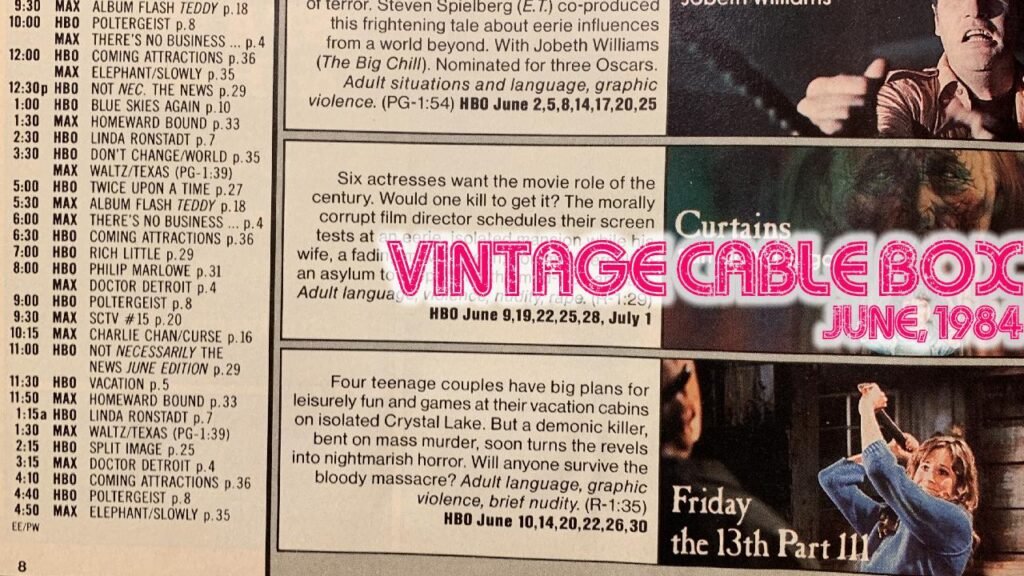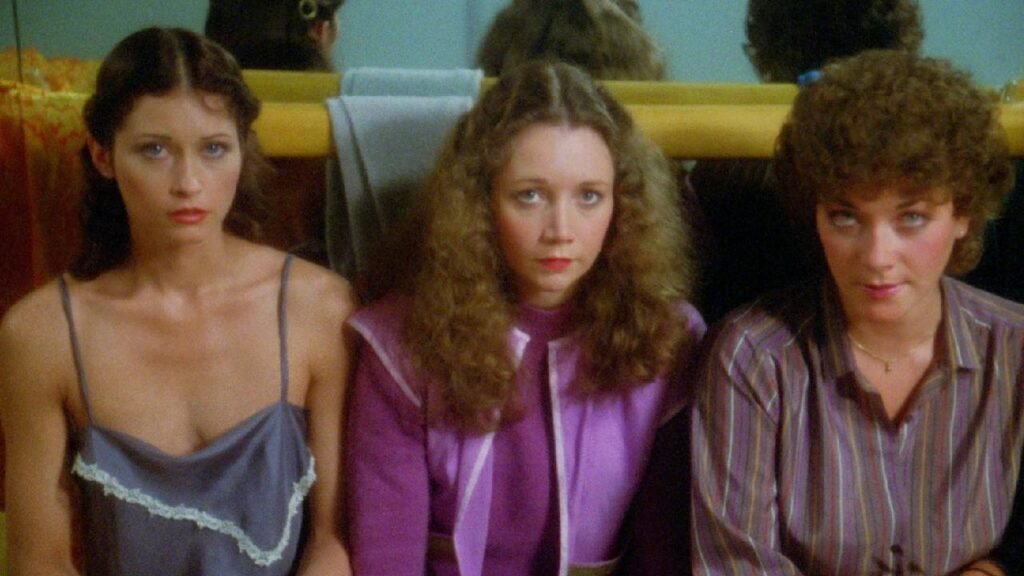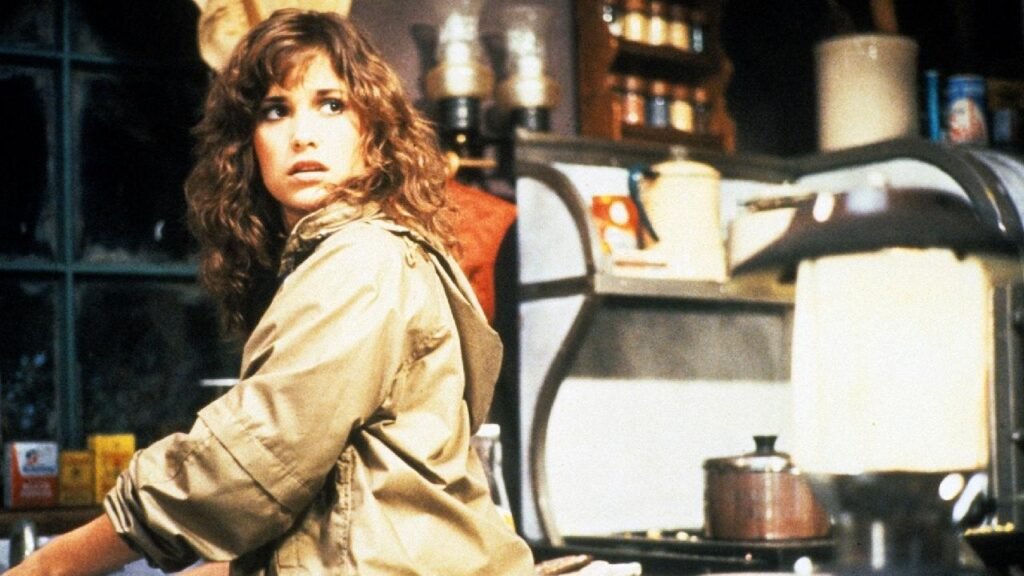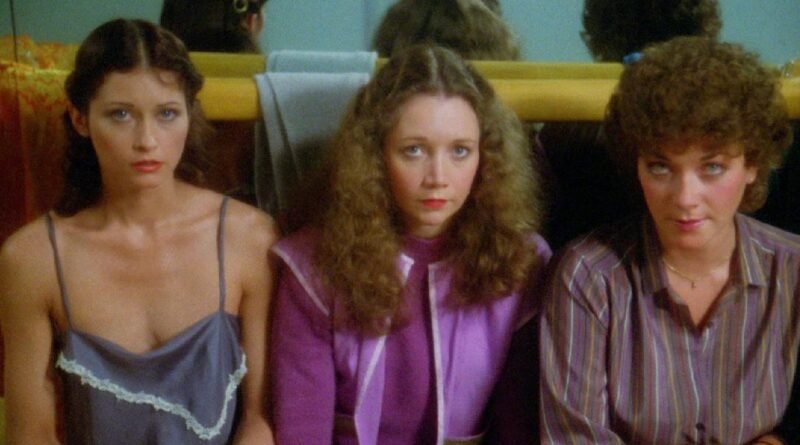Vintage Cable Box June 1984: Poltergeist/Curtains/Friday the 13th Part III

Poltergeist, 1982 (JoBeth Williams), MGM/UA
“Cross over, children! All are welcome. All welcome. Go into the light!”
Before Poltergeist, director Tobe Hooper’s main claims to fame (or infamy, as the case may be) were The Texas Chainsaw Massacre in 1974 (I’ll never forget the death of Kirk) and an excellent television adaptation of Stephen King’s Salem’s Lot in 1979. A personal favorite of mine, The Funhouse, was released in 1981. Poltergeist, in 1982, appears in the eye of a visual effects super-storm, preceded by Raiders of the Lost Ark, and enveloped by Ghostbusters with striking, visceral animations created by Industrial Light & Magic and supervised by Richard Edlund.
After Poltergeist, Hooper would direct Lifeforce (1985), a remake of Invaders from Mars (1986), and a criminally underrated sequel to The Texas Chainsaw Massacre. Without the combined elements of Hooper, Steven Spielberg, ILM, and the music of Jerry Goldsmith, Poltergeist would be just another horror movie; a generic hodge-podge of ghost movie tropes, jump-scares, and repetitive horror conventions.
The Freelings (JoBeth Williams, Craig T. Nelson) are a good-looking, pot-smoking couple living in a planned community in Orange County; part of a new real estate development bulldozing over an ancient Indian cemetery (always a bad decision, especially in horror movies), and they begin to notice strange occurrences on the property (their property specifically). Chairs and other pieces of furniture seem to move of their own volition.

Late one night, their youngest, Carol Anne (Heather O’Rourke), starts talking to the static in the television. Well, that’s peculiar. The next night, Carol Anne disappears and little Robbie (Oliver Robins) is attacked by a monstrous tree outside his bedroom. The Freelings call their friendly neighborhood ghost-busters (Beatrice Straight, Richard Lawson, Martin Casella) who then sub-contract to the diminutive, iconic Zelda Rubinstein to “clean” their house of supernatural disturbances.
As with most people, nobody likes to be evicted, and the spirit world collides with the material world with slimy veracity. In the film’s climax, the skeletons in the burial ground come alive and terrorize JoBeth and the children as Craig packs up their belongings so they can get the hell out of there. My only question is why does the spirit world have such a ridiculous hard-on for this family and nobody else?
The Poltergeist franchise suffers from unfortunate coincidences and controversies. Both Dominique Dunne (who played eldest Freeling daughter, Dana) and O’Rourke died tragic deaths at young ages. Two other actors associated with movies in the franchise also died of medical ailments. Speculation about the “Poltergeist Curse” has led people to believe this was due to the production using real human bones and skeletons during the film’s climax.
It’s also rumored Spielberg directed most of the movie because, in an early press release, Spielberg stated Hooper wasn’t “…a take-charge sort of guy.” I don’t doubt Spielberg brought a considerable amount of input to the movie. He co-wrote the screenplay, which was based on his story. He produced the movie, but the shots and set-ups are Hooper’s. Poltergeist is Tobe Hooper’s film, from start to finish.
Curtains, 1983 (Samantha Eggar), Jensen Farley Pictures
“You haven’t spent five minutes with me and now you’re telling me I’m wrong for the part. Why? Because I haven’t got a staple to my navel like that centerfold? Because I wouldn’t pirouette into bed with you and skate on your face? I mean, what the hell are you looking for anyway and what do you want from me? I mean, who the fuck is Audra anyway?”
It’s been a long time since I actually sat down and lost myself in a movie, even to the point of forgetting I was supposed to be reviewing the movie, but here we are with Curtains from 1983 made by people I hadn’t heard of, produced and distributed by a company I had never heard of. I remember the movie from the HBO guide appearing in a trio of horror movies, but it always seemed to play in the middle of the night (on school nights), so it was difficult to grab.
What I did know of the movie was the cast: John Vernon (Dean Wormer from National Lampoon’s Animal House), Samantha Eggar, and Lynne Griffin (the pretty girl from Strange Brew). I love being able to sit back and enjoy an old movie and then to remember why I love movies, particularly those old movies. Curtains is ambitious, but it isn’t ambitious to the point of losing all touch with reality.
It’s fairly simple, but it is different for a Canadian slasher movie. There are a series of unexpected bluffs right at the beginning, so you know you’re going to be manipulated and misdirected at nearly every turn. Samantha Eggar is a respected actress who checks into a sanitarium to research a role in director Jonathan Stryker’s latest project, a psychological thriller titled Audra.
After a time, it becomes clear Stryker is not going to cast her. She breaks out of the asylum (after spending some particularly depressing nights there) and reads in the trades that Stryker will be holding auditions at his snowbound isolated manse. The actresses, among them Linda Thorson and Anne Ditchburn, all have interesting talents. One dances. One is a figure skater.

Griffin herself is a part-time stand-up comic whose routines often consist of failed auditions. She makes jokes constantly to cover for her insecurities. Eggar crashes the auditions, surprising Stryker, and hoping to get another crack at the part. If it were me, I would’ve given her the part rather than be a bastard filmmaker, but that’s me. Vernon seems more creepy than charismatic, or perhaps he’s just consumed in his own ego.
If he isn’t seducing his actresses, he’s putting them through a series of mind games. Horror movies of this kind are generally not this thoughtful. The slasher movie takes a different turn because it relies more on a story than a series of shocks, and because Curtains is a product of its time, it takes a while to set up each killing. You know the girls are going to be offed, but how and when remain refreshingly mysterious.
I also enjoyed that there was little in the way of punctuating music. There were moments of silence which lent to the overall tension. Yes, the killer wears a mask, and yes, there are accompanying orchestral stings in the score, but Curtains never goes overboard. This kind of stuff used to scare the hell out of me when I was a kid.
Halfway through the movie, I began to suspect Stryker was trying to drive these girls mad as part of their auditions and ultimate rehearsals for the movie. Kind of like how Kubrick was rumored to have driven Shelley Duvall to the brink of madness. The ultimate revelation of the killer (or killers) may leave you scratching your head, but the journey is well worth it.
Friday the 13th Part III, 1982 (Richard Brooker), Paramount Pictures
“Shelly, this had better not be another one of your jokes.”
We pick up right where we left off with the previous Friday the 13th movie, and then I begin to suspect these opening scenes exist only to pad out the running time. Basically, we have Ginny (the survivor from Part 2, and, not coincidentally, a thoughtful and intelligent young woman played by Amy Steel) trying to pass herself off as Pamela in order to confuse and delay Jason (now revealed to be the killer) so she can get away.
There’s a subtle character bit here with Jason that I didn’t think about. Ginny pretends to be Jason’s mother and when she admonishes him for disobeying her, he cocks his head in a quizzical manner, as though he were a puppy who just heard an unusual noise. I thought that was fantastic. So Ginny escapes, we go back to the grotesque shrine of Pamela, and we’re off to the races!
This is Friday the 13th Part III (in 3-D, as evidenced by the credits, but for some reason we’re treated to a disco theme this time around). I’m assuming the credits are supposed to be smacking our faces if we’re wearing the 3-D glasses, but here they mercifully stop before messing up my monitor. Phew! Steve Miner directs an immediate follow-up to the first sequel with the discovery of all the dead teens from Part 2.
Jason is somewhere still out there, clutching a machete, and it isn’t long before we get our first confirmed kill. This is the first sequel (in my worn-down memory, at least) to step up the action and get right down to business. We get the fake-out jolts, of course accompanied by Harry Manfredini’s violin stings (his score emulates Bernard Hermann’s score for Psycho), but we also get a handful of enhanced shots for 3-D; snakes coming toward us, assorted weaponry, and a “clever” gag with a yo-yo.
There’s a refreshing amount of quiet that escalates the tension, because at this point we’re waiting for Jason to strike. After vanquishing an argumentative couple with a fondness for pets, we’re introduced to the requisite teens with the van that’s a-rockin’. These guys aren’t as likeable as the previous batch, but it is admittedly easier to watch them buy a one-way ticket to the bone orchard.

I remember being somewhat upset and alarmed that Adrienne King was the first to go in the previous movie, but as I get to understand and appreciate the formula, I realize this is the only way to move forward in a franchise. We can’t have long-term heroes (or heroines) in slasher films. It gets boring after a while. This is evidenced by the on-again, off-again presence of Jamie Lee Curtis in the Halloween franchise.
The formula of the franchise represents a deviation from the first two movies. These kids aren’t camp counselors, but a group of old friends (though they don’t act all that friendly with each other, the girls are somewhat bitchy to each other, and the guys are deliberately dense) spending a weekend together in a town that neighbors Crystal Lake. They are menaced by a strange ’80s version of a multicultural biker gang.
So, in addition to weathering the storm of Jason’s vengeance, they have to deal with these idiots, who also swear vengeance. There’s a lot of vengeance in New Jersey, isn’t there? The biker idiots show up, attempting to rain on the kids’ parade, but they get knocked off by Jason, in increasingly inventive ways, and it’s interesting to note several of the killings are done off-screen.
While continuing to use POV shots for Jason, this is the movie in which we get to see more than just a few shots of him. He dons the iconic hockey mask (as played by Richard Brooker) for the first time and shoots an arrow straight through a victim’s eye! Visually, the movie looks a lot better than most of the 3-D films being released at the time.
Shot on a budget twice that of the previous film, Friday the 13th Part III did a little better at the box office, but not quite as groundbreaking as the first movie in the franchise, but by this time, slasher films took over a good portion of the market. Friday the 13th Part III is likely the last movie in the franchise to show Jason as a human being with physical vulnerabilities, unlike what he would eventually become: that of a super-human killing machine.
Our first cable box was a non-descript metal contraption with a rotary dial and unlimited potential (with no brand name – weird). We flipped it on, and the first thing we noticed was that the reception was crystal-clear; no ghosting, no snow, no fuzzy images. In June of 1984, HBO and Cinemax broadcast an incredible, eclectic assortment of movies. Vintage Cable Box returns to highlight each of those movies, as well as offering new appraisals and providing context into what was cable television in the mid ’80s. It was a different cultural landscape at the time, and these movies offered an education that went far and above film school. Vintage Cable Box explores the wonderful world of premium Cable TV of the early eighties. Enjoy!
Special thanks to Dave Hooser for scanning the HBO/Cinemax guide and sharing these pictures.

